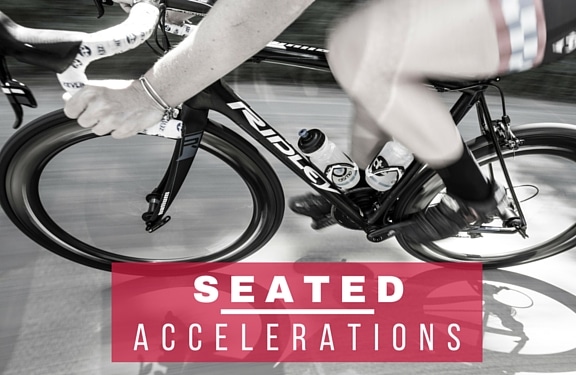
Use This Seated Acceleration Workout to Ride the Competition Off Your Wheel!
Launching out of the saddle to attack the group you’re riding with can be very effective, but it’s also very obvious! No matter if you come from the back or accelerate from the front of the group, your plan is immediately apparent. You’re telegraphing your punch! A strong seated acceleration can be a huge asset, and has set up some of the most spectacular victories in recent memory.
Last weekend Peter Sagan stormed to victory in the Tour of Flanders and he did it with a seated acceleration on the Paterberg, the final cobbled climb of the race, in almost the exact spot Fabian Cancellara did the same thing to him on his way to winning the Ronde Van Vlaanderen in 2013. And that 2013 Ronde wasn’t the first time Cancellara had pulled that move. In 2010 he won the Tour of Flanders with a seated acceleration on the Muur van Geraardsbergen (otherwise known as the Kapelmuur), dropping Tom Boonen so dramatically that conspiracy theories about a motor in his bike still persist (a theory revived by last winter’s discovery of an actual motor inside Femke Van den Driessche’s bike at the Cyclocross World Championships). And it doesn’t always have to come on a climb or cobbled climb. Cancellara attacked with a seated acceleration on a flat, smooth road 47 kilometers from the finish in the 2010 Paris-Roubaix and soloed in for victory.
A powerful, seated acceleration is exceptionally useful on rough surfaces because having your weight on the saddle helps maintain traction. But they are also a stealthier way to attack because your riding style doesn’t visibly change very much. As a result, your initial surge may go unnoticed or underestimated, and by the time your competition realizes this is a full-force attack, you have a gap and they are scrambling to chase back on. When you telegraph your acceleration by loudly shifting gears, launching yourself out of the saddle, and swinging your bike back and forth, everybody knows exactly what’s going on and you have given them more of a chance to respond. That doesn’t mean an out of the saddle attack is bad; if you have enough fitness and hit the group at the right time, a powerful attack will still work.
Training for Seated Accelerations
A great seated acceleration should make the competition wonder what just happened. When it works, people will say you never really attacked; you just rode everyone off your wheel. To the rider directly behind you, nothing really looked any different, the speed just spiked and you were gone. Training for this kind of acceleration has to be a specific seated acceleration cycling workout, meaning you have to not only train for accelerations, but also keep your butt on the saddle!
[blog_promo promo_categories=”coaching” ids=”” /]Seated Speed Intervals
Each set of Seated Speed Intervals is a series of short accelerations and short recovery periods. A common variation of this workout is 10x20seconds acceleration with 20 seconds easy spinning between each. In practice, you essentially accelerate hard for 20 seconds, spin as you gradually slow down over 20 seconds, and then go again. Your starting speed should be 15+mph or around 100-150watts, basically a moderate pace so you both have some momentum and have capacity to accelerate. Starting very slow and accelerating against a big resistance is also good, but that’s a different workout. Beginners can do one set of 10×20/20 Seated Speed Intervals in a workout, intermediate riders can do two sets (separated by 5-8 minutes of recovery), and advanced riders would be better off doing more intervals in each set, like 12-16×20/20 sets. Another tip: do at least some of these efforts in the drops. You should train to accelerate hard in a variety of riding positions, including in the drops.
Have a Great Weekend, and enjoy watching Paris-Roubaix!
Chris Carmichael
CEO/Head Coach of CTS
► Free Cycling Training Assessment Quiz
Take our free 2-minute quiz to discover how effective your training is and get recommendations for how you can improve.
Related Links
Paris-Roubaix 1988 – The Greatest Race Everyone Forgot About
Lessons You Can Learn From Watching the Spring Classics
Misery Is a Choice: Developing Mental Toughness in Endurance Athletes
► FREE Mini-Course: Learn How to Maximize Your Limited Training Time
Learn step-by-step how to overcome limited training time and get faster. Walk away with a personalized plan to increase your performance.
"*" indicates required fields


Comments 1
Toward the end of a race, I like to use a seated acceleration to lead out a false sprint. When the riders around you jump out of the saddle to respond, they are wasting their energy, and then you can pop out of your saddle to give it the extra kick to win. Plus, a seated acceleration like this toward the end lets you spin up your cadence to where you can shift into a higher gear and not have to worry about a loud click that gives it away, or shifting while out of the saddle, in the middle of a sprint, which I always try to avoid.